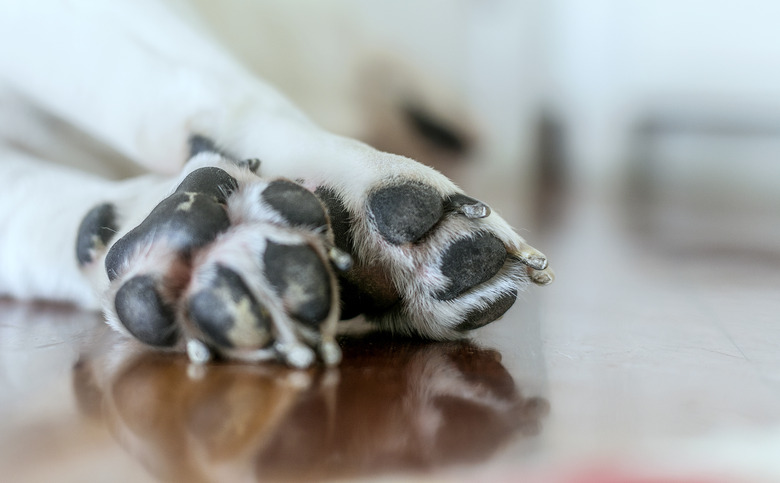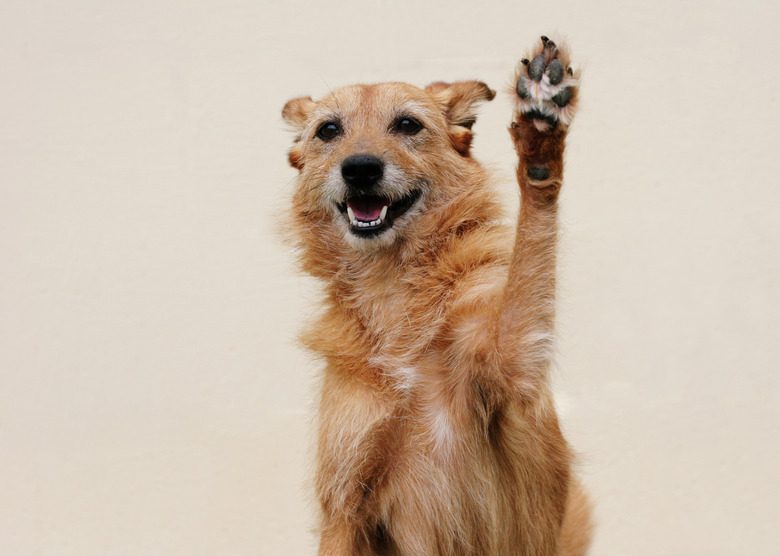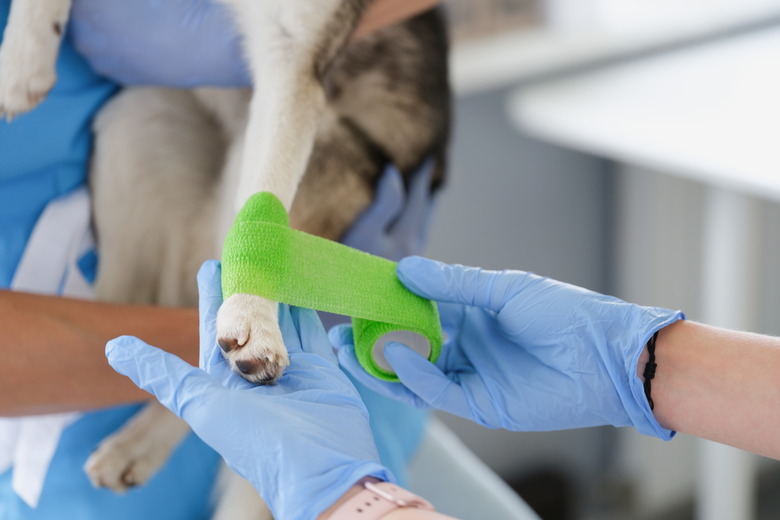How To Care For A Dog's Torn Paw Pad
If your dog starts limping or leaving bloody footprints, it's likely something is wrong with her foot or paw pad. You can probably bandage a minor injury on your own, but don't hesitate to go to the vet if the injury seems serious or your dog won't let you near her.
Dog paw pad function and structure
Dog paw pad function and structure
A dog's paw pads are truly wondrous things, the canine version of shock absorbers. The four digital pads protect the toes. The metacarpal pad protects the front feet and the metatarsal pad, the rear paws. There's also the carpal pad on the back of the front leg. This is otherwise known as the "stopper pad." This aids the dog when she's going up or down steep slopes.
A dog's paw pads help her distinguish the type of terrain on which she's moving. Breeds originating in cold climates have larger-than-normal paw pads, and that's because their pads help them navigate ice and snow. Dogs bred for endurance have so-called cat feet. Their paw pads are more rounded, and they don't need to use as much energy to lift their feet.
Inspect and clean the your dog's foot
Inspect and
clean the your dog's foot
Look at your dog's foot as carefully as possible. If she's in pain, she may seem wary of being touched. For safety's sake, you may need to muzzle your dog. Search for any foreign object that may have become lodged in her paw pad.
If you spot a foreign object, such as a glass shard, try to remove it with tweezers. However, if the object is stuck deep within the pad, you'll need to take the dog to the vet for treatment. Taking a cold hose to the foot may help rid it of small particles. Wash the foot with antibacterial soap or use an antiseptic povidone solution for cleaning and disinfecting.
In many cases, dogs will only injure or scrape away the surface layer of epidermis from the paw pads. While the paw pad will be raw and sensitive, there is usually only minimal bleeding. Keep the injury clean and dry. If your dog seems to be in a lot of pain, you can bandage the paw and consult your veterinarian about pain medications, but this is rarely necessary for minor scrapes.
Bandaging an injured dog paw
Bandaging an injured dog paw
If the dog paw is bleeding or has a more serious cut, it needs bandaging. Small wounds will stop bleeding within a few minutes. A deeper wound will take more time and may require pressure to address the bleeding. If the bleeding doesn't stop within 15 minutes, it's wise to take your pet to the vet. If the bleeding does stop, try to prevent your dog from walking on the foot for a while. Try putting her in a crate for an hour or so or leaving her in a small room where she can't move much.
For best results, after cleaning, bandage the foot with a nonstick gauze pad and self-adhesive bandage tape. Make sure to cover the entire paw, beyond the wound area and up to the next joint on the dog's leg. This will vary according to whether the injury involves a front or back paw. To ensure the bandage isn't too tight, keep it flexible enough so that you can place two fingers between the foot and the bandage.
Check and change your dog's bandage
Check and change your dog's bandage
Change the bandage daily. Odds are your dog isn't going to be like having this item on her paw and may try to remove it. You may need to use some type of product designed to discourage licking or chewing. An Elizabethan collar can make it more difficult for your dog to chew on their bandage.
If you notice a foul odor when changing the bandage or if the foot swells up, take your dog to the vet. A dog with a cut paw pad that continually reopens also requires veterinary attention.
Does your dog's paw need stitches?
Does your dog's paw need stitches?
Sometimes a paw pad injury will need suturing, and that's something you can determine when initially inspecting the wound. Any cuts that are jagged or deep should be sutured. If your dog is really uncooperative and won't let you look at her foot, take her to the vet. For such canines, sedation may prove necessary for anyone to get a good look at the injured foot.
Any sort of deep cut is more prone to infection. The vet can prescribe antibiotics to help prevent such an infection from taking hold.
Let the torn paw pad heal
Let the torn paw pad heal
The healing process will vary, depending on the severity of the paw pad injury and the dog's activity level. Keep the dog as quiet as possible, and when she must go outside for calls of nature, wrap the bandaged foot gently with a plastic bag beforehand so the bandage doesn't get wet or dirty. You can also purchase dog booties for this purpose.


